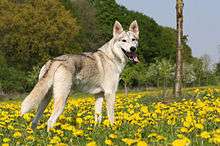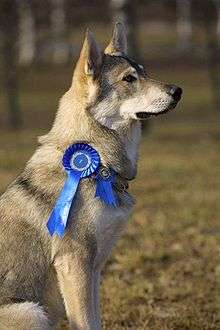Tamaskan Dog
 A Tamaskan dog | |||||||||||||||||||||||||||||||||
| Common nicknames | Tam, Tamaskan husky | ||||||||||||||||||||||||||||||||
|---|---|---|---|---|---|---|---|---|---|---|---|---|---|---|---|---|---|---|---|---|---|---|---|---|---|---|---|---|---|---|---|---|---|
| Origin | Finland | ||||||||||||||||||||||||||||||||
| |||||||||||||||||||||||||||||||||
| Domestic dog (Canis lupus familiaris) | |||||||||||||||||||||||||||||||||
The Tamaskan dogs are a crossbreed, specifically designed by dog fanciers, beginning in Finland, to morphologically resemble a wolfdog. It is a cross of several standardized breeds of the sled dog type, and its bloodlines may sometimes include a small amount of wolfdog stock. As of November 2013, Tamaskans have not been recognized as a breed in its own right by any major breed registries or kennel clubs, only being recognized by two minor registries, the American Rare Breed Association, and the related Kennel Club of the United States of America,[1][2] and by Tamaskan-specific breeder clubs. It is a highly versatile dog that can excel in agility, obedience and working trials. Although there are a little over 600 Tamaskans worldwide registered in these organizations, increasing interest has resulted in their spread throughout continental Europe, the UK, United States, Canada, and Australia.
Description

Tamaskans are large, athletic dogs, slightly taller in size than German Shepherds. With regard to build, they are substantially larger than typical sled dogs but smaller than the Alaskan Malamute. They generally resemble grey wolves and wolfdogs.

On average, Tamaskan adults measure around 24-28 inches (60–70 cm) tall at the shoulder and typically weigh between 55-88 pounds (25–40 kg)–the heaviest recorded Tamaskan males (to date) weigh just under 50 kg. Females are usually slightly smaller and lighter than males, with a distinct feminine appearance. Males are more heavyset with broader heads and a heavier bone structure. Tamaskans have a lupine appearance with a straight bushy tail and thick double coat that comes in three main colors: wolf gray, red gray, and black gray. Each individual guard hair is agouti banded along its length. The almond-shaped eyes range from yellow through to amber and brown, with lighter colored eyes being very rare. Blue eyes are not acceptable, nor are mismatched eyes.[3]
Health

Overall, the Tamaskan variety is healthy; only a few notable health issues affect a small percentage of the bloodlines to date. Roughly 10% of males suffer from cryptorchidism: undescended testes. With these cases, usually only one testicle fully descends within the scrotum, while the other testicle remains "hidden" up within the abdominal cavity. Epilepsy has been diagnosed in five dogs, affecting about 1 out of every 100 registered Tamaskans worldwide. Several dogs have been found to be carriers of degenerative myelopathy. As with all large breed dogs, hip dysplasia is a risk.
History

In the early 1980s, five dogs, of Siberian Husky origin, were imported into the UK from America. These dogs were then bred to the Siberian Husky, Alaskan Malamute, and German Shepherd, but also possibly other breeds exhibiting a lupine phenotype, to form a variety called the Utonagan dog. The Utonagan was perhaps later crossed with the Czechoslovakian Wolfdog to form the Tamaskan dog as it is known today.
In 2009, the Tamaskan Dog Register introduced a Saarloos Wolfdog as a single out-cross to bring some fresh blood into the breed. However, it is believed that none of his progeny have been bred from it to date. This particular Saarloos was specifically selected due to his great temperament, appearance, and health.[4]
Breed clubs
There are breed clubs in the United States (US Tamaskan Dog Club),[5] Canada (National Tamaskan Club of Canada),[6] France (Club Français du Tamaskan),[7] Germany (Tamaskan Club Germany),[8] the Netherlands (Nederlandse Tamaskan Club),[9] Croatia (Hrvatski Tamaskan Savez),[10] and the United Kingdom (Tamaskan Dog Society of Great Britain).[11]
Famous Tamaskan dogs

In October 2007, a Tamaskan named Genghis Khan featured as a wolf in a music video for the band Lucretia Choir.[12]
In September 2010, a TDR registered male Tamaskan named Wave became the official Live Mascot of North Carolina State University's football team: NC State Wolfpack. Wave (aka "Tuffy") now attends most home games and can be seen stalking around the sidelines.[13][14][15][16]
In September 2012, four Tamaskans were featured on the Croatian HRT 1 television program Kućni ljubimci.[17]
In September 2015, a Tamaskan named Adler (White Elk Brighid) appeared in several news outlets including the Daily Mail, the Boston Times, and the Bark Post for mastering the game of Tug-of-War by using her mass instead of her strength.[18]
In 2016, a Tamaskan named Luchta (White Elk Luchta) appeared on Broadway. Luchta played the role of "The Wolf" in Arthur Miller's The Crucible produced by Scott Rudin and directed by Ivo van Hove.[19]
References
| Wikimedia Commons has media related to Tamaskan. |
- ↑ "International Tamaskan Forum – Login".
- ↑ "Kennel Club USA – Tamaskan Dog".
- ↑ "Tamaskan Pictorial Standard".
- ↑ "The History of the Tamaskan Breed". Tamaskan-Dog. Retrieved 22 April 2016.
- ↑ "US Tamaskan Dog Club". US Tamaskan Dog Club.
- ↑ "National Tamaskan Club of Canada".
- ↑ "Club Français du Tamaskan".
- ↑ "Tamaskan Club - Startseite". Tamaskan Club.
- ↑ Rahne Meeder. "Home - Nederlandse Tamaskan Club". Nederlandse Tamaskan Club.
- ↑ "Hrvatski Tamaskan Savez / Croatian Tamaskan Club". Facebook.
- ↑ "Tamaskan Dog Society of Great Britain". Tamaskan Dog Society of Great Britain.
- ↑ Paul Hornsey. "Lucretia Choir: News".
- ↑ "Local & North Carolina state news from Raleigh, NC - NewsObserver.com".
- ↑ "The Daily Tar Heel :: N.C. State to Use Tamaskan Dog for Mascot".
- ↑ "Celebrity Pets Must See Photos and Videos - PEOPLE Pets : People.com". PEOPLE.com.
- ↑ "NC State's Live Mascot "Tuffy"".
- ↑ "1156. Emisija "Kućni ljubimci", HTV 1, 22.09.2012. 10:10 sati - Facebook".
- ↑ "Adler the dog takes the lazy route in tug-of-war against her furry friend ... by never getting up".
- ↑ FOX (2016-06-14). "WATCH: Adorable dog stars is the hottest star on Broadway! - Story | WWOR". My9nj.com. Retrieved 2016-08-20.
External links
- The Florida Lupine News Volume 9 Issue 3 (Autumn 2007)
- Animal Wellness Magazine 7447079635 Volume 10 Issue 1 (Feb-Mar 2008)
- Dogs Monthly - March 2009 Issue
- Dogs Today July 2009 Issue (Pages 24 & 25)
- Dogs Today - November 2009 Issue (front cover)
- Dogs Today July 2010 Issue
- Dogs Today August 2010 Issue
- Dogs Today September 2010 Issue
- Das deutsche Hunde Magazin November 2011
